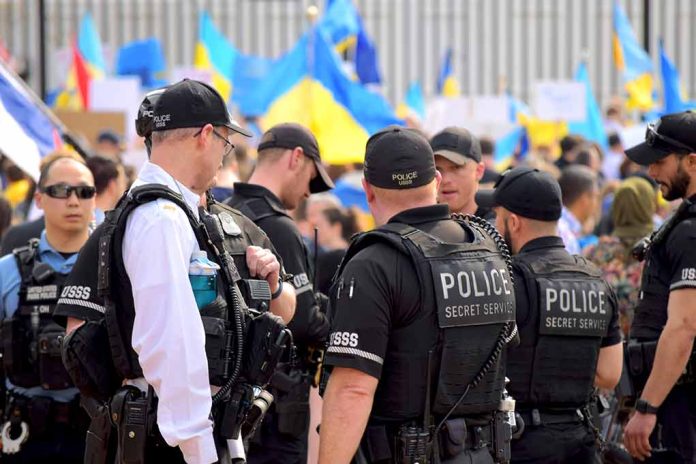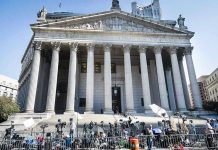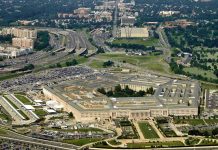
Los Angeles Mayor Karen Bass has pulled police from the Palisades Fire burn zone to deal with anti-Trump riots while simultaneously blaming President Trump for the city’s escalating unrest and resource allocation crisis.
Key Takeaways
- Mayor Bass has withdrawn LAPD officers from Pacific Palisades fire zone checkpoints to redirect resources toward managing “No Kings” anti-Trump protests
- Bass directly blamed President Trump’s “federal escalation” and ICE enforcement for causing the riots that necessitated the resource shift
- Despite ongoing violence and protests, Bass insists current unrest is “zero comparison” to the 1992 riots and downplays the severity of the situation
- Police Chief Jim McDonnell confirmed that planned anti-Trump demonstrations required significant reallocation of law enforcement resources
- Bass claims ICE enforcement has delivered a “bodyblow” to Los Angeles’ economy, particularly affecting construction, fashion, and restaurant industries
Bass Redirects Police Resources Away From Fire Victims
Los Angeles residents in the Pacific Palisades area have been left vulnerable after Mayor Karen Bass ordered the removal of police checkpoints that had been protecting the Palisades Fire burn zone since January 7. These checkpoints were originally established to prevent looting of evacuated properties following the devastating wildfires. The decision to withdraw police protection comes at a time when the LAPD is stretched thin dealing with ongoing riots and large-scale demonstrations across the city, particularly the “No Kings” protests that have frequently descended into violence.
LAPD Chief Jim McDonnell acknowledged that the planned protests were a significant factor in the decision to reallocate police resources away from the fire zone. With thousands of demonstrators taking to the streets, law enforcement has been forced to prioritize containing widespread unrest over maintaining security checkpoints in recovering neighborhoods. The timing of this decision has raised serious questions about the city’s ability to protect all its citizens during multiple simultaneous crises.
Mayor Blames Trump Administration for City’s Unrest
In a remarkable deflection of responsibility, Mayor Bass has directly attributed the city’s ongoing civil unrest not to the violent protestors themselves, but to President Trump’s administration and its immigration enforcement policies. Bass specifically cited what she termed “federal escalation” as the driving force behind the riots, suggesting that ICE operations within the city were the true cause of the violence rather than the individuals participating in the destruction of property and attacks on police officers.
“The disruption and the fear that has been caused by the raids has really had a devastating effect and has been a body blow to our economy. I don’t think the president understands that we have entire sectors of our economy that cannot function without immigrant labor,” Said Karen Bass.
Bass has gone further by claiming that the riots will continue as long as federal immigration enforcement persists in Los Angeles. This statement has been interpreted by critics as tacit approval for the demonstrations, which have resulted in injuries to both police officers and civilians. Rather than condemning the violence or taking stronger measures to protect city infrastructure, Bass has focused her criticism on the Trump administration’s policies rather than addressing the local response to the unrest.
Downplaying the Severity of the Crisis
Despite widespread media coverage showing burning vehicles, vandalized buildings, and violent confrontations between protesters and police, Mayor Bass has repeatedly attempted to minimize the severity of the situation facing Los Angeles. In public statements, she has insisted that the current unrest bears no resemblance to the 1992 Rodney King riots, which she personally witnessed.
Bass has characterized reports of chaos in Los Angeles as inaccurate, emphasizing that the anti-ICE riots have been confined to a relatively small area within the sprawling city. This characterization comes despite the implementation of a citywide curfew, numerous arrests, and the redeployment of police resources from protecting fire victims to managing protesters. The mayor’s minimization of the crisis has frustrated many residents who are experiencing the direct impacts of the unrest, particularly those in the Pacific Palisades who have now lost police protection during their recovery from devastating wildfires.
Resource Allocation Challenges Expose City’s Vulnerabilities
The decision to remove police checkpoints from the Palisades Fire zone highlights a critical resource allocation problem facing the city. With LAPD officers now focused on containing widespread protests and riots, other areas of the city are left with reduced protection. This zero-sum game of public safety resources underscores the challenges of maintaining order in a major metropolitan area during multiple simultaneous crises, especially when city leadership appears reluctant to take a hard line against violent demonstrators.
While Bass continues to emphasize that “safety and security remain paramount,” her administration’s actions suggest that certain neighborhoods and communities may be sacrificed in the name of managing political demonstrations. The Pacific Palisades situation serves as a stark example of how political priorities can directly impact public safety decisions, leaving vulnerable citizens to fend for themselves while resources are diverted to address politically charged conflicts elsewhere in the city.













